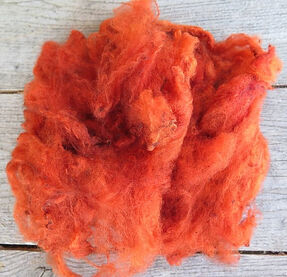The Plant[]

Madder (Rubia tinctoria) is native to western and central Asia. It has become naturalized in parts of central and southern Europe as well. [1] Madder can grow from 1-1.5 meters tall and the roots can be over 3 feet long. [2] Madder can be bought from some garden centers or grown from seed. It prefers well-drained, basic soil.
How to Harvest[]
The root of the madder plant is used for dyeing and should be grown for 2-3 years before harvesting. Roots are lifted in autumn and portions of the root may be retained for replanting. The largest roots contain the most pigment and will provide more even results than smaller roots. After lifting, roots are dried at low temperatures in an oven or dehydrator. However, too much heat or moisture can reduce the intensity and quality of color. [1]
How to Extract Color[]

The highest quality pigment can be found in the central part of the roots and is called the krappe or crop. This dye can create bright reds and oranges. The outer parts of the roots and stems can be used to create an inferior dye called mull, which can be used to dye browns. Once the root is graded, it is usually ground into a powder for maximum dye extraction [1] Whole root segments can be used for a less intense color.
It is recommended that a dye bath is made with enough madder to equal 30-40% of the weight of the fiber, yarn, or fabric. [1] Some sources suggest at least 50%. [3] Ground or whole madder is added to a dye pot full of water and heated to 82°C (180°F) for 40 minutes. The heat is turned off and the madder is left to steep overnight. An alternative method is to

pour boiling water over the madder roots and leave for 10 minutes. Drain the water and then put in new water and simmer. This can help remove the brown pigments. If the roots are old it can also help to let them soak in a small amount of water before any preparation is done.
Then bring the dye bath back up to 82°C (180°F), add mordanted or unmordanted fiber, yarn, or textiles, and simmer for anywhere between 20 minutes to no more than two hours. [2] By exceeding this temperature or time frame, the dyer risks turning the textiles dull brown. [1]
Pre-mordanting with alum will give a true red or orange. By making the dye bath alkaline shades can be shifted towards a truer red. By making it acidic and increasing temperature you get brigher oranges. Scarlet can be achieved by adding tin to the dye bath during the last 15 minutes. [1]
References[]
- ↑ 1.0 1.1 1.2 1.3 1.4 1.5 Cannon, J., & Cannon, M. (1994). Dye plants and dyeing (p. 76). Portland, Or.: Timber Press.
- ↑ 2.0 2.1 Duerr, S. (2010). The handbook of natural plant dyes: Personalize your craft with organic colors from acorns, blackberries, coffee, and other everyday ingredients (pp. 147-149). Portland, Or.: Timber Press.
- ↑ Furry, M., & Morrison, B. (1935). Home dyeing with natural dyes. Washington, D.C.: U.S. Dept. of Agriculture.